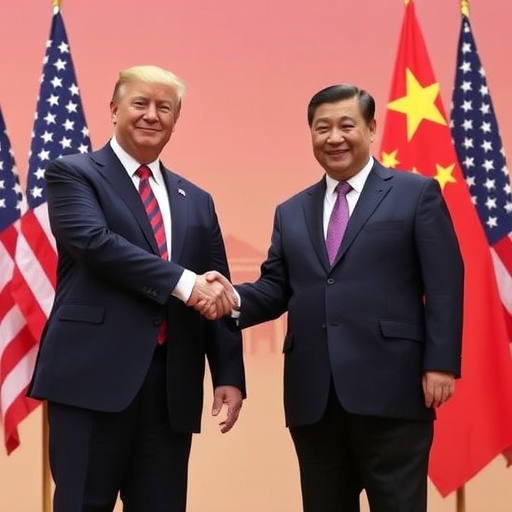US-China trade Deal Breakthrough: Framework Averts 100% Tariffs and Rare Earth Controls as Trump and Xi Gear Up for Summit
In a stunning diplomatic pivot that has sent shockwaves through global markets, the United States and China have hammered out a preliminary trade framework, dodging the brink of a full-blown economic showdown. Treasury Secretary Scott Bessent revealed the agreement on Monday, highlighting how it sidesteps the U.S.’s threatened 100% tariffs on Chinese imports and Beijing’s retaliatory controls on rare earth exports. This development comes just days before Presidents Donald Trump and Xi Jinping are slated to meet in South Korea to iron out the final details, offering a glimmer of hope amid years of US-China trade tensions.
The announcement marks a significant de-escalation in the ongoing US-China trade saga, which has seen billions in tariffs imposed since 2018. With rare earth minerals—critical for everything from electric vehicles to defense technology—nearly weaponized in the dispute, this framework could stabilize supply chains worldwide. Bessent emphasized that the deal focuses on “reciprocal market access and intellectual property protections,” without delving into specifics, but sources close to the negotiations suggest concessions on both sides to prevent further escalation.
Treasury Secretary Bessent Unveils Key Framework Elements
Treasury Secretary Scott Bessent, a key architect of the Trump administration’s economic strategy, took center stage at a White House briefing to outline the contours of the new US-China trade framework. Speaking with measured optimism, Bessent stated, “This agreement represents a pragmatic step forward, averting measures that would have crippled industries on both sides of the Pacific.” He detailed how the framework addresses core irritants in US-China trade, including unfair subsidies for Chinese state-owned enterprises and barriers to American agricultural exports.
At its heart, the deal proposes phased reductions in existing tariffs, starting with a 25% rollback on select electronics and machinery imports. In exchange, China has pledged to ease restrictions on rare earth exports, which account for over 80% of the global supply dominated by Beijing. According to U.S. Geological Survey data, the U.S. imports nearly $200 million worth of rare earth compounds annually from China, making these minerals indispensable for high-tech manufacturing. Bessent highlighted that without this accord, export controls could have driven prices up by 300%, echoing the disruptions seen during the 2010 Sino-Japanese dispute over the Senkaku Islands.
Experts are buzzing about the inclusion of a bilateral investment treaty clause, aimed at leveling the playing field for U.S. firms in China. “This isn’t just about tariffs; it’s about rebuilding trust in the global trading system,” said Dr. Elena Ramirez, a trade policy analyst at the Brookings Institution. She noted that the framework builds on the Phase One deal from 2020, which saw China commit to purchasing $200 billion in U.S. goods but fell short on enforcement.
Behind the scenes, marathon talks involving U.S. Trade Representative Katherine Tai and Chinese Vice Premier Liu He paved the way. Insiders reveal that virtual sessions intensified last month after intelligence reports warned of potential rare earth hoarding by Beijing, prompting urgent White House intervention.
From Tariff Threats to De-Escalation: The High-Stakes Backdrop
The path to this framework was littered with escalating threats that had markets on edge. Just weeks ago, President Trump warned of imposing 100% tariffs on all Chinese imports if Beijing didn’t curb its rare earth export policies, a move that could have added $500 billion to annual U.S. consumer costs, per estimates from the Peterson Institute for International Economics. In retaliation, China signaled it might invoke its 2023 export licensing regime more stringently, targeting rare earths vital for semiconductors and renewable energy tech.
US-China trade has been a powder keg since the Trump era’s initial salvos in 2018, when tariffs on $360 billion of Chinese goods were slapped on, citing national security concerns. China fired back with duties on $110 billion of U.S. products, hitting soybeans and autos hardest—sectors still reeling today. The rare earth angle added a layer of strategic peril; these 17 elements are used in F-35 fighter jets, iPhones, and wind turbines. A 2023 report by the International Energy Agency warned that disruptions could delay global EV adoption by years, with the U.S. holding only 1.5% of mining capacity.
Market reactions to the tariff threats were visceral: the Dow Jones dipped 2% in early trading last Friday amid fears of a trade war redux. “Investors were pricing in the worst—supply shortages and inflation spikes,” observed JPMorgan analyst Raj Patel. But post-announcement, Asian indices surged 3%, with the Shanghai Composite leading the charge, underscoring the deal’s immediate relief valve.
Stakeholders from Silicon Valley to Midwest farms breathed easier. Apple, heavily reliant on Chinese assembly, saw its stock rebound 4%, while U.S. farmers, battered by prior trade spats, anticipate renewed soybean exports—China remains the top buyer, importing 30 million tons yearly.
Trump and Xi’s South Korea Summit: Finalizing the Trade Pact
All eyes now turn to Busan, South Korea, where Presidents Trump and Xi Jinping will convene later this week for what could be a landmark summit. Hosted on neutral ground to facilitate candid dialogue, the meeting aims to seal the framework into a binding agreement. Trump, known for his deal-making flair, tweeted post-announcement: “Big progress with China—tariffs off the table, rare earths flowing. Heading to South Korea to make it official with President Xi!”
Xi, facing domestic pressures from a slowing economy, views the summit as a chance to project stability. Chinese state media hailed the framework as “a win-win for mutual prosperity,” quoting Foreign Ministry spokesperson Lin Jian: “This demonstrates the maturity of our bilateral relations.” The agenda reportedly includes side discussions on technology transfers and climate cooperation, tying US-China trade to broader geopolitical ties.
Security protocols are tight, with the summit coinciding with the Asia-Pacific Economic Cooperation forum. Analysts predict Trump will push for verifiable commitments on rare earth quotas, while Xi may seek assurances against future U.S. export bans on advanced chips—a sore point after Biden-era restrictions. “The chemistry between Trump and Xi could make or break this,” said former U.S. Ambassador to China Max Baucus. Their 2017 Mar-a-Lago meeting set a positive tone before tariffs erupted; this summit echoes that potential.
Logistically, the event features bilateral dinners and working sessions, with input from advisors like Bessent and Liu He. If successful, it could extend to a trilateral U.S.-China-South Korea trade initiative, boosting regional stability.
Market Rally and Industry Wins from Averted Trade Disruptions
The framework’s reveal triggered a euphoric market response, with U.S. futures climbing 1.5% overnight and European bourses following suit. Tech giants like Tesla and Nvidia, vulnerable to rare earth bottlenecks, posted gains of 5-7%, as investors bet on uninterrupted supply lines. “This averts a nightmare scenario for clean energy transitions,” noted BloombergNEF’s energy transition expert, Sarah Chen, who forecasts a 15% drop in rare earth prices if the deal holds.
In the U.S., manufacturing sectors stand to gain immensely. The auto industry, which uses rare earths in electric motors, could save $10 billion annually, according to the Alliance for Automotive Innovation. Tariffs on steel and aluminum—lingering from 2018—might see partial lifts, benefiting companies like Ford and GM. Agriculture, too, eyes a boon: U.S. pork exports to China, down 50% post-trade war, could rebound with tariff relief.
Globally, the deal ripples through supply chains. Australia and Canada, ramping up rare earth mining, welcome reduced Chinese dominance, potentially diversifying sources. A World Trade Organization report estimates the framework could add 0.5% to global GDP growth in 2025 by easing US-China trade frictions, which shaved 0.3% off growth in 2019.
Critics, however, caution against complacency. Labor unions like the AFL-CIO argue the deal doesn’t address job losses from offshoring, with 2 million U.S. manufacturing positions evaporated since 2001 due to China’s WTO entry. Environmental groups push for sustainable rare earth mining clauses, citing pollution in Inner Mongolia’s Bayan Obo mines.
Long-Term Implications: Reshaping US-China Trade Dynamics
Looking ahead, this framework could herald a new chapter in US-China trade, fostering deeper integration while safeguarding national interests. If Trump and Xi ink the deal in South Korea, implementation might begin within 90 days, involving WTO notifications and joint oversight committees. Rare earth safeguards could include U.S. stockpiling incentives, echoing the Defense Production Act’s recent activations.
Geopolitically, it tempers U.S. efforts to decouple from China, instead promoting “friendshoring” with allies like Vietnam and Mexico. Economists project $100 billion in untapped trade opportunities, from biotech to AI, if IP protections strengthen. Yet challenges loom: midterm elections could politicize the pact, and Beijing’s economic slowdown—GDP growth at 4.7% in Q3—might strain commitments.
For consumers, the wins are tangible: lower gadget prices and stable energy costs. As one Wall Street Journal op-ed put it, “This isn’t the end of the trade wars, but a vital ceasefire.” With Trump and Xi’s summit on the horizon, the world watches to see if this momentum endures, potentially averting a fractured global economy for years to come.
(Note: This article draws on official announcements, market data from Bloomberg and Reuters, and expert analyses as of the publication date.)








